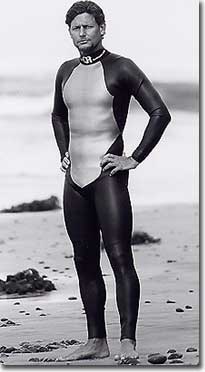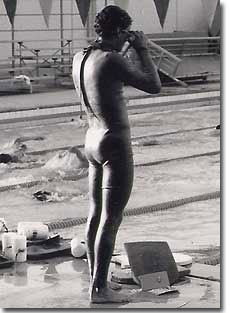Proprietary rubber in today’s tri wetsuits
In some ways life was easy for me when I began as a wetsuit manufacturer. I didn't have to explain why my wetsuits were better than anyone else's, or why my rubber was superior, or different. I had no competitors. I did have other problems, such as answering ad nauseum, "Why do triathletes need wetsuits?"
It didn't take long for people to figure out the answer to that one, and within two years I had a couple of competitors. Now, 20 years later, there are no fewer than a dozen companies making wetsuits that deserve to have their brands purchased. No, these companies don't face the question, "Why wetsuits?" Now the question is, "Why your wetsuit?"
This has led to companies coming up features with crafty names and registered trademarks and maybe these features mean something special and maybe they don't. Go back 18 or 20 years and I'll tell how my catalog might've read:
- – Swim in our wetsuit and notice our exclusive SkinAbrader(R) neckline.
- – While gliding through the water feel our StrokeRestrictor(R) back panels.
- – Have your wetsuit take itself off, while you're swimming, with our AutoDetach(R) zipper slider.
- – Feel the power of your fingernails as they pierce the EasySlice(R) thigh panels.
Funny how nobody talks up the crappy features in his wetsuits.
But time marches on and my wetsuit company kept doing the good things, fixed the bad things, and we tried to move the ball forward. Of course all manufacturers tried to make better fitting, faster, more comfortable, more durable, wetsuits than they did the year before. That included trying to use raw materials that nobody else was using. Chiefly, that meant rubber.
There are several companies that say they have rubber nobody else has. Let's take a look at those claims, and the rubber they're using, and see what we can glean about the state of materials in the wetsuits we use today.
Let's start with a baseline for the rubber typically used in triathlon wetsuits. Starting around 1990 or thereabouts I began using blown rubber from a company that had never sold to any triathlon wetsuit makers, and of course there were only three or four of us so there weren't many opportunities for a rubber supplier. That was Yamamoto rubber company, and triathlon turned out to be the entre into the water sports market for Yamamoto. We liked this company because of one of its two types of rubber made. There was it's so-called #38, and it was a fine, well-made, consistent-quality, blown rubber. The other was its #39, which was a softer, lower- density rubber that was perfect for a high-end triathlon wetsuit. After seeing and using #39, we switched immediately to Yamamoto's rubber.
A year or so later this company came out with its Super Composite Skin, also known as SCS. This again was a nice move forward, because the SCS surface applied atop the smoothskin repelled water, and had a wet look to it. It looked fast, and it was fast. Even more important, it solved a big problem for us: SCS was very tough, and protected #39 rubber from fingernail tears.

Another year or two went by, and Yamamoto showed us yet another surface, which it called METAL. This is the silver colored smoothskin rubber you see often used in wetsuits. It's functionally no different than the black-colored SCS, it's just silver. We were not the first to sell this in a triathlon wetsuit. We were the first to see it, but its application on the suit was inconsistent, and we deferred to other companies and waited to employ it until the quality was correct. When it was ready for prime time, we used it as well, and an example is the suit at left.
This brings us to the state of triathlon materials as of about 10 years ago. When you look at wetsuits made today, you are chiefly looking at the rubber I've been describing. Almost nothing has been done to improve rubber over the past 10 years.
But that's not the whole story. There are several rubber products that Yamamoto has developed since then, but in general they are derivative of the rubber described already.
Yamamoto has since developed #45 rubber, but this is a denser, heavier rubber and has not caught on in triathlon. A style of METAL has caught on with Aquaman, and De Soto dabbled in it some time back. The idea is to create a suit with SCS surface on both the inside and outside of the suit. While smoothskin is hard to slide over the a nearly naked body when it's dry, SCS is not. It's really a great surface to have against your skin, because it doesn't trap and foster mildew. Consider surfers, and the abrasion resistance they need on the outside of their suits, and the need to stave off mildew on the inside. Fabric on the suit's exterior is fine for a surfer. Take a triathlon wetsuit and turn it inside out, that's a pretty good way to make a surf wetsuit. As stated, though, some of Aquaman's suits have panels that are smooth inside and out.
Quintana Roo is making its suits out of Yamamoto Type 40 rubber, and has an exclusive use of this rubber, at least for triathlon. The story of Type 40 rubber bears a lot in common with the story of Viagra. As is the case with that notable drug, the genesis of the product carried with it another purpose. For Viagra, it was vasodilation, but not in quite so specific a part of the anatomy. For Type 40, it was for deep-water free divers. The rubber resists compression at depth.

Now, when I heard QR was using this rubber, the irony put a smile on my face. In 1986, when I first started my investigation into what rubber ought to go into a triathlon wetsuit, I came across a company called Rubatex that made smoothskin rubber. I chose was style G231N, and it was unique in its construction. This was nitrogen gas blown rubber, and its special feature was its ability to withstand compression at depth. It was a favored rubber by those making very flexible dive suits. That first fullsuit I made in 1986 out of G231N rubber is at left.
Whether Yamamoto Type 40 is inert gas blown rubber I do not know, however the QR folks discovered this rubber, were impressed with its flexibility and softness, and took it as their own. Whether it is demonstrably better for triathlon wetsuits is another question I can't answer, at least not as of this writing. But it's interesting to know that QR's current and former owners find value out of rubber that works well not only on top of the water, but underneath it as well.
It should surprise no one that Dean Jackson, QR's brand manager, would attach his brand to a new style of rubber out of the Yamamoto factory. Jackson in another life was Orca's UK distributor, and Orca has a habit of coming up with rubber made by Yamamoto that only it has access to. Most recently it has been Orca's Airlite rubber. Imagine a 1.5mm sheet of rubber that has SCS-coated smoothskin on one side, and fabric on the other side. This is the sort of rubber that might go in a wetsuit's arm. Now, imagine splitting that rubber, so that you now have two sheets half that thick. The surface where you split the rubber is intuitively called "split," or sometimes "cell." So now you have SCS one side / split one side, and then you have jersey one side / split one side. In between these sheets goes a sheet of rubber perforated with holes 4mm in diameter, and then it's all laminated together like a layer cake. Let's say that perforated sheet is 3.5mm thick. You then have a 5mm panel piece that, Orca says, floats much better, because of the air pockets.
What Orca calls Airlite is what Yamamoto calls AeroDome. Whether it works as advertised is again a question for others to decide. It was certainly ingenious. And it is now open platform, that is, Orca no longer enjoys the exclusive it has had over the past 3 years. There are rumblings another joint Yamamoto-Orca product may be in the works, but nothing more on that yet. Whether other companies use this rubber is a tough marketing call. If you don't use it, you may be giving up a competitive advantage. If you do, you're validating Orca's original concept — you're admitting they had a better material than you did during the period of the exclusive.
Yamamoto is not the only maker of blown rubber out there. Indeed, it is not nearly the largest. That distinction probably goes to Sheico, a Taiwanese maker of both blown rubber and finished goods. Sheico is generally considered a high quality, though not uniquely superior, maker of blown rubber. Its real claim to fame is its jersey, that is, the fabric attached to its rubber. But in triathlon the jersey is not that important, except for its stretch characteristics. As a result, Sheico is not a major player in triathlon wetsuits.
There is a South Korean company by the name of Jako Chemical, and it's got no name recognition in triathlon, but a fairly interesting pedigree in our sport. We used Jako quite a bit in the 90s, in our price point suit. Jako made very consistent, high quality — but average density — rubber. Nothing special, but perfect for $200 wetsuits. Now Jako may have taken a step up and made a lower-density, softer rubber akin to Yamamoto's #39. It has also made, so we hear, a nice SCS-like surface treatment designed to rival Yamamoto's. We have not yet seen this rubber, but one veteran wetsuit supplier is favorably disposed enough to choose this over Yamamoto's rubber. No doubt, price is an issue in this decision. We'll report as we know more.
There is only so much you can do with rubber. You can put a try to make the smoothskin surface smoother or slicker or more tear resistant. you can impress the surface with a pattern as the blown rubber "bun" is baking. You can treat finished rubber by smashing it with a die, creating a pattern. Most "pulling panels," whether they work or not, are made this way.
You can attach just about anything to the "cell" or "split" that you get as you slice sheets from the bun. You can attach regular jersey, "superstretch" or "ultrastretch" jersey, polypropylene, and even two- sided tape. Many triathletes have used this application for their aerobar pads. You adhere two sided tape, smack the rubber with a steel ruled die, cutting out little pattern pieces in the shape of the armrest trough. HED makes its aerobar armrests this way.
When you think about it, the creative and compelling ideas in the wetsuit market today didn't result from a new method of making rubber, or a substance other than traditionally blown rubber. Yamamoto took its existing rubber and had it split, perforated and laminated and made something new and unique for Orca out of existing technologies. Zoot created a one-piece suit with considerable flexibility through layering one pattern piece over another — but without the creation of any new rubber. De Soto made a wetsuit that, again, exhibits great flexibility, but through design, not because of a breakthrough in raw goods.
Materials are not the killer app in tri wetsuit technology. Creativity and execution have moved this industry forward almost exclusively over the past 15 years, and nothing now known suggests that it will be anything but this over the near term.

